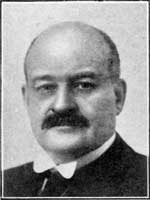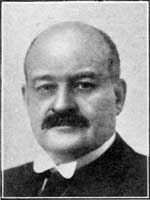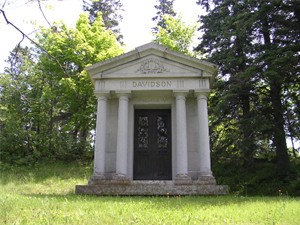He served as a director of 44 companies; he was President of Davidson and McRae Company, President of the Canadian Western Lumber Company, and Vice-President of the Columbia River Lumber Company. He also had interests in coal, grain and elevator companies, and the Western Canada Flour Mills. For a time, he was land commissioner of the Canadian Northern Railway, based at Toronto. He was involved in a number of business enterprises with Mackenzie and Mann. He was given the honorary title of "Colonel" in recognition of his service to the state of Minnesota.
He and wife Ella T. McRae had one daughter. In early 1916, he went to the Mayo Clinic at Rochester, Minnesota suffering from "acute stomach trouble". He died there on 22 April 1916 and was buried at Forest Hill Cemetery in Duluth, Minnesota.
Sources:
Who's Who in Western Canada: A Biographical Dictionary of Notable Living Men and Women of Western Canada, Volume 1, 1911. C. W. Parker, editor. Canadian Press Association, Vancouver.
The Story of Manitoba
by F. H. Schofield
The S. J. Clarke Publishing Company, 1913.
This collection of biographies of Manitobans was compiled by the Canadian Publishing Company, and published at Winnipeg in 1913. Most of those featured in the book were living at that time, so no information on death dates was provided. Where possible, these have been added to this online version.
Online version 2009-2010, Manitoba Historical Society.
________________________________________
"Col. A. D. Davidson dies at Rochester" Manitoba Free Press, 24 April 1916.
"Funeral of Col. Davidson" Manitoba Free Press, 25 April 1916.
In 1902, at the urging of the Canadian government, Colonel Andrew Duncan Davidson formed the Saskatchewan Valley Land Company and began aggressive campaigns to promote immigration to the area. As much of Davidson's advertising was aimed at Americans, his marketing strategy included naming some of the townsite's streets after former US presidents. Andrew Davidson was immensely successful: the first few settlers arrived in 1902, but in 1903 waves of homesteaders began pouring into the region. The Meshens built a house in town that year, the post office was established, and by early 1904 about 15 businesses were in operation--largely in makeshift shacks. Two years later, the population of the community was over 500, and on November 15, 1906, Davidson became a town. It developed into a trading centre for a large area that included the WATROUS, Long Lake, ELBOW, and OUTLOOK districts, and soon earned the nickname "The Midway Town" because of its location between the cities of Saskatoon, Regina and MOOSE JAW. Today, Davidson serves an immediate trading area of over 10,000 people and has a wide array of business providing a variety of goods and services. Davidson is also one of the province's major grain handling points and agricultural service centers. Its weekly newspaper, the Davidson Leader, was established in 1904. Because of the community's central location, it has become established as a meeting place for businesspeople and a variety of organizations from Saskatchewan's major cities. Its 7.3-metre-high coffee pot, situated on the highway, symbolizes the town's position as a hospitality centre.
He served as a director of 44 companies; he was President of Davidson and McRae Company, President of the Canadian Western Lumber Company, and Vice-President of the Columbia River Lumber Company. He also had interests in coal, grain and elevator companies, and the Western Canada Flour Mills. For a time, he was land commissioner of the Canadian Northern Railway, based at Toronto. He was involved in a number of business enterprises with Mackenzie and Mann. He was given the honorary title of "Colonel" in recognition of his service to the state of Minnesota.
He and wife Ella T. McRae had one daughter. In early 1916, he went to the Mayo Clinic at Rochester, Minnesota suffering from "acute stomach trouble". He died there on 22 April 1916 and was buried at Forest Hill Cemetery in Duluth, Minnesota.
Sources:
Who's Who in Western Canada: A Biographical Dictionary of Notable Living Men and Women of Western Canada, Volume 1, 1911. C. W. Parker, editor. Canadian Press Association, Vancouver.
The Story of Manitoba
by F. H. Schofield
The S. J. Clarke Publishing Company, 1913.
This collection of biographies of Manitobans was compiled by the Canadian Publishing Company, and published at Winnipeg in 1913. Most of those featured in the book were living at that time, so no information on death dates was provided. Where possible, these have been added to this online version.
Online version 2009-2010, Manitoba Historical Society.
________________________________________
"Col. A. D. Davidson dies at Rochester" Manitoba Free Press, 24 April 1916.
"Funeral of Col. Davidson" Manitoba Free Press, 25 April 1916.
In 1902, at the urging of the Canadian government, Colonel Andrew Duncan Davidson formed the Saskatchewan Valley Land Company and began aggressive campaigns to promote immigration to the area. As much of Davidson's advertising was aimed at Americans, his marketing strategy included naming some of the townsite's streets after former US presidents. Andrew Davidson was immensely successful: the first few settlers arrived in 1902, but in 1903 waves of homesteaders began pouring into the region. The Meshens built a house in town that year, the post office was established, and by early 1904 about 15 businesses were in operation--largely in makeshift shacks. Two years later, the population of the community was over 500, and on November 15, 1906, Davidson became a town. It developed into a trading centre for a large area that included the WATROUS, Long Lake, ELBOW, and OUTLOOK districts, and soon earned the nickname "The Midway Town" because of its location between the cities of Saskatoon, Regina and MOOSE JAW. Today, Davidson serves an immediate trading area of over 10,000 people and has a wide array of business providing a variety of goods and services. Davidson is also one of the province's major grain handling points and agricultural service centers. Its weekly newspaper, the Davidson Leader, was established in 1904. Because of the community's central location, it has become established as a meeting place for businesspeople and a variety of organizations from Saskatchewan's major cities. Its 7.3-metre-high coffee pot, situated on the highway, symbolizes the town's position as a hospitality centre.
Sponsored by Ancestry
Advertisement
Explore more
Sponsored by Ancestry
Advertisement




